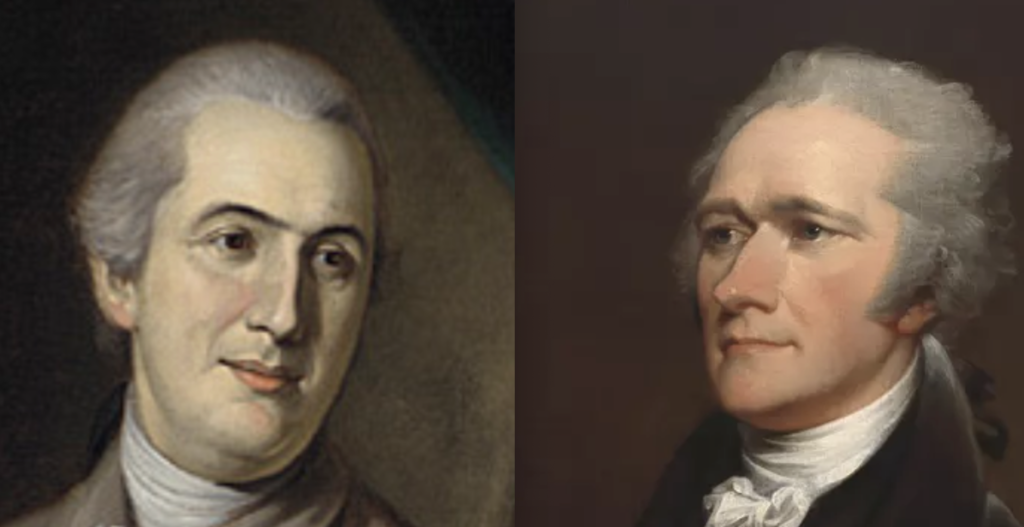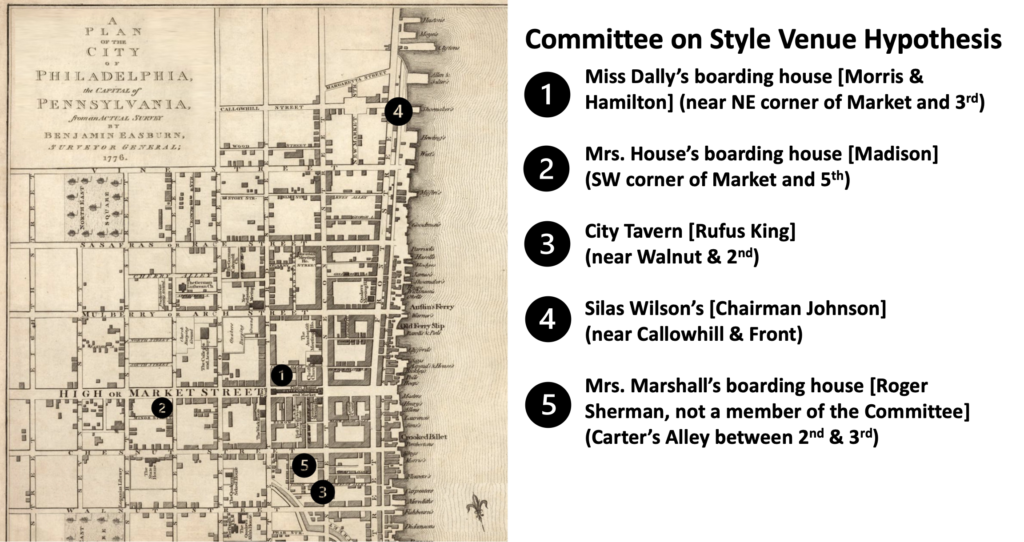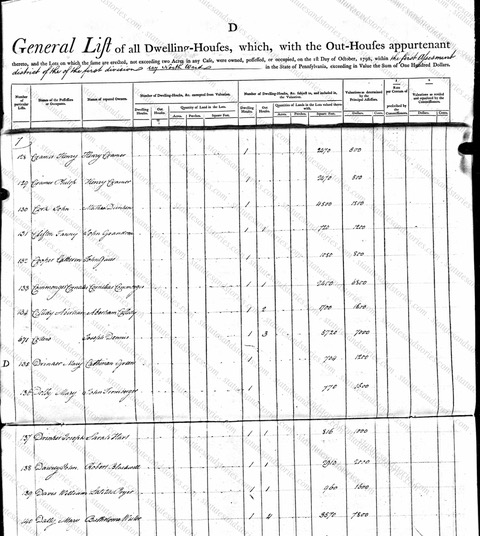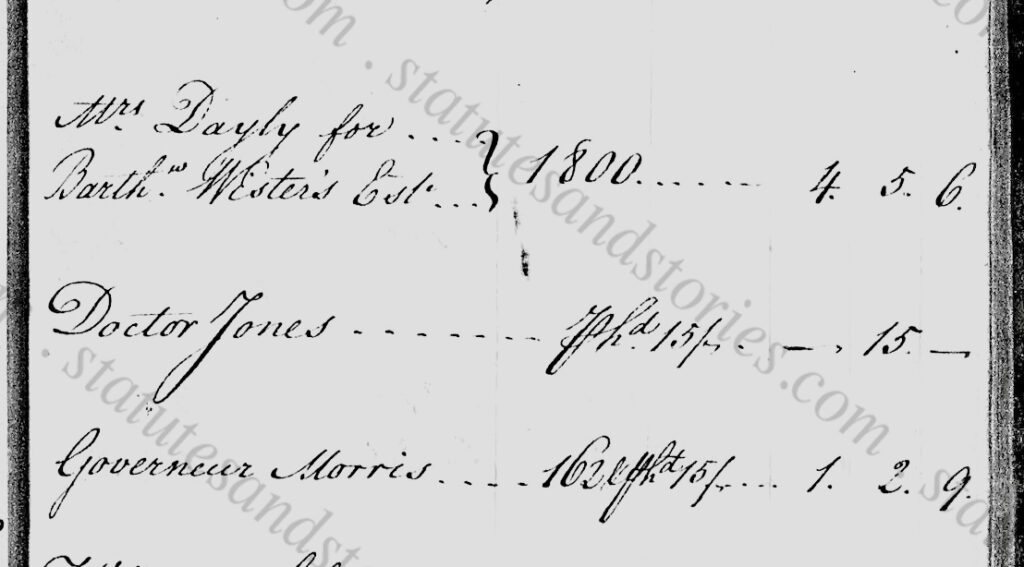Committee on Style Venue Hypothesis: Miss Dally Part IV
Alexander Hamilton and Gouverneur Morris were lifelong friends and political allies. Hamilton and Morris served together on one of the Constitutional Convention’s most important committees, the Committee on Style. This blog post – Miss Dally Part IV – theorizes that Hamilton and Morris were closely collaborating at Miss Dally’s boarding house in September of 1787. If so, Miss Dally’s boarding house may be one of the most important addresses in American history.
Part IV proposes that the Committee on Style operated out of Miss Dally’s boarding house between September 8 to September 12 (hereinafter the “Committee on Style Venue Hypothesis”). While admittedly there is no direct documentary evidence for the Committee on Style Venue Hypothesis, the body of growing circumstantial evidence suggests that Miss Dally’s boarding house was the most convenient, central location for the Committee on Style to meet when drafting the all-important September 12 draft of the Constitution, which included the Preamble.
Committee on Style
Committees played a vital role in the drafting of the Constitution during the summer of 1787. Without a doubt, one of the most important committees was the “Committee on Style and Arrangement.” Despite its unassuming name, the Committee on Style was charged with preparing the final draft of the Constitution. While generations of historians have agreed on the importance of the work of the Committee on Style, there is no consensus where the Committee met. In other words, despite abundant scholarship on the Committee’s work, the location where the committee met remains an open question.
The Committee on Style was created in the final days of the Philadelphia Convention. As indicated by Madison’s notes (pictured above), the five-member Committee on Style was selected “by ballot” on September 8th. On the morning of September 12th the Committee submitted its report. During a span of less than four days the Committee on Style not only prepared the final draft of the Constitution, it also drafted the Constitution’s transmittal letter to Congress (hereinafter the “Cover Letter”) and two critical ratification resolutions.
Unlike prior committees, it is abundantly clear that the Committee on Style was comprised of the most ardent nationalists at the Convention (Alexander Hamilton, Gouverneur Morris, James Madison and Rufus King). These four delegates were remarkable for their youth and shared commitment to an “energetic” federal government that could address the exigencies confronting the nation. The fifth member of the committee, Chairman William Samuel Johnson from Connecticut, was the oldest committee member. It is generally agreed that Johnson may have been selected to play a supervisory/organizational role.
For example, on the day the Committee was created Chairman Johnson traveled to the Falls of the Schuylkill to dine with Thomas Mifflin. Likewise, the day after the Committee was appointed Johnson visited John Penn’s country home, Lansdowne. Johnson’s schedule suggests that the heavy lifting of the Convention occurred outside of the committee meetings. Johnson’s diary indicates that the Committee on Style met after dinner on September 8th and on the 10th and 11th, before submitting their draft “report” on September 12.
In his book, The Genius of the People [1], Charles Mee describes the members of the Committee on Style as follows:
Five members were appointed to the committee: the practical Rufus King, the mastermind Madison, the conciliatory Connecticut delegate Johnson, and the two great prose stylists in the hall, Gouverneur Morris and Alexander Hamilton.
So where did this historic Committee meet?
Miss Dally research
During the past several years StatutesandStories.com conducted wide-ranging archival research regarding Miss Dally’s boarding house. Historians have long suspected that Gouverneur Morris boarded with Miss Dally during the Constitutional Convention. Using Gouverneur Morris’ bank records at the Library of Congress, Part I confirms that Morris began boarding/sub-letting space with Miss Dally in late 1782.
When he wasn’t traveling on business or visiting the family’s Morrisania estate in New York, Morris continued boarding at Miss Dally’s through September of 1787. Following the Constitutional Convention Morris relocated to Morrisania, which he had acquired from his brother earlier in the year. Click here for a discussion of Alexander Hamilton’s involvement in the loyalist claim and Morris family litigation involving the Morrisania estate; click here for a discussion of the complex financial transactions and arbitration which enabled Morris to purchase Morrisania from his half-brother, who was a member of Parliament.
Part II focuses on Miss Dally and her largely forgotten boarding house. Part II uses correspondence between delegates at the Constitutional Convention, newspaper ads by Miss Dally, memoirs and diaries to piece together the list of founders who boarded with Miss Dally. Because Miss Dally and her sister, Mrs. Clarke, operated boarding houses for over a decade, their names repeatedly appear in the correspondence between members of Congress.
Part III builds on Gouverneur Morris’ bank records by compiling overlooked property tax rolls and receipts/expense reports involving Miss Dally’s boarding house. These primary sources uncovered in the Massachusetts and Pennsylvania State Archives further solidify the conclusion that Gouverneur Morris resided/sublet space in Miss Dally’s building in September of 1787 when he drafted the Preamble.
Part V summarizes the limited historical record mentioning Miss Dally. Part V is organized around a series of research topics, presented in a question-and-answer format. Thus, Part V is intended to provide a roadmap for future researchers and fellow travelers.
Collaboration between Morris and Hamilton at Miss Dally’s:
Alexander Hamilton and Gouverneur Morris were lifelong friends and political allies. Years after the Constitution was written, in a letter to Rufus King dated 2 October 1798, Hamilton said of Morris that “Men like him do not super-abound.” In turn, Morris praised Hamilton’s “brilliant” service during the War, “heroic spirit,” “splendid talents,” and “incorruptible integrity.” Click here for a link to Morris’ July 14, 1804 oration at Hamilton’s funeral. Twenty years earlier, in May of 1784, Morris arranged for Alexander Hamilton to represent Morris’ mother, Sarah. At the time, Morris correctly anticipated that his mother would be sued by Gouverneur’s half-brother, Richard Morris.
Historian Richard Brookhiser authored biographies of both Hamilton and Morris. For Brookhiser, it was clear that “personally and politically” Hamilton and Morris were “soul-mates.” Hamilton biographer Forrest McDonald notes that Hamilton and Morris met at Valley Forge and would become “intimate social and political” friends for the rest of Hamilton’s life. [2]
Historian Peter Hoffer indicates that Morris was Hamilton’s “friend to the end.” Morris was present at Hamilton’s deathbed and delivered the oration at Hamilton’s funeral. [3] Shortly after his tragic death, a distraught Eliza Hamilton described Morris as her husband’s “best friend.” [4]
Focusing on the monumental work of the Committee on Style between September 8 to September 12, Professor Richard Treanor describes the close connections between Morris and Hamilton:
The closest tie on the committee, however, was between Morris and Hamilton. There was a natural bond between the two, outgoing, witty New Yorkers, both lawyers, both educated at Columbia, with similar politics and a common interest in finance (although, as will be discussed, very different personal backgrounds). The two had first worked together during the Revolutionary War when Hamilton was aide de camp to Washington and Morris a member of the Continental Congress inspecting the military. Hamilton revered the slightly older Morris for his intelligence and presence, and the two established a strong friendship. They worked closely together when Hamilton was in Congress and Morris the Assistant Superintendent of Finance.
Treanor also recognizes that Hamilton and Morris both had “deep ties” to George Washington. The closeness of their relationships is evident from the fact that Morris gave funeral orations for both.
Historians universally acknowledge that Hamilton and Morris were two of the strongest nationalists – if not the strongest nationalists – at the Convention. “Where other delegates at the Convention spoke of themselves as representatives of their states, Morris (a New Yorker elected to represent Pennsylvania) proclaimed that he came ‘as a Representative of America . . . in some degree as a Representative of the whole human race.’ ” [5]
While they came from strikingly different backgrounds, both Hamilton and Morris shared a similar “continental” perspective and disdain for narrow, parochial prerogatives which undermined abiding national interests. According to Ron Chernow, “By dint of his youth, foreign birth, and cosmopolitan outlook, [Hamilton] was spared prewar entanglements in provincial state politics, making him a natural spokesman for a new American nationalism.” [6]
At the Convention on July 5, Morris criticized those who sought “to truck and bargain for [their] particular States.” [7] For Morris, “State attachments, and State importance have been the bane of this Country.” [8] While Hamilton was not present at the time, Hamilton surely would have agreed. On July 7, Morris argued that “[i]t has been one of our greatest misfortunes that the great objects of the nation had been sacrificed constantly to local views….” [9] For years, dating back to his Continentalist essays, Hamilton had been making the same point. As summarized by Hamilton biographer John C. Miller, “as early as 1781, Hamilton had come to the conclusion that ‘the present futile and senseless Confederation’ ought to be scrapped forthwith.” [10] In Continentalist I, Hamilton warned that the federal government under the Articles of Confederation would “continually grow weaker” until its “dissolution” or its “violent end.”
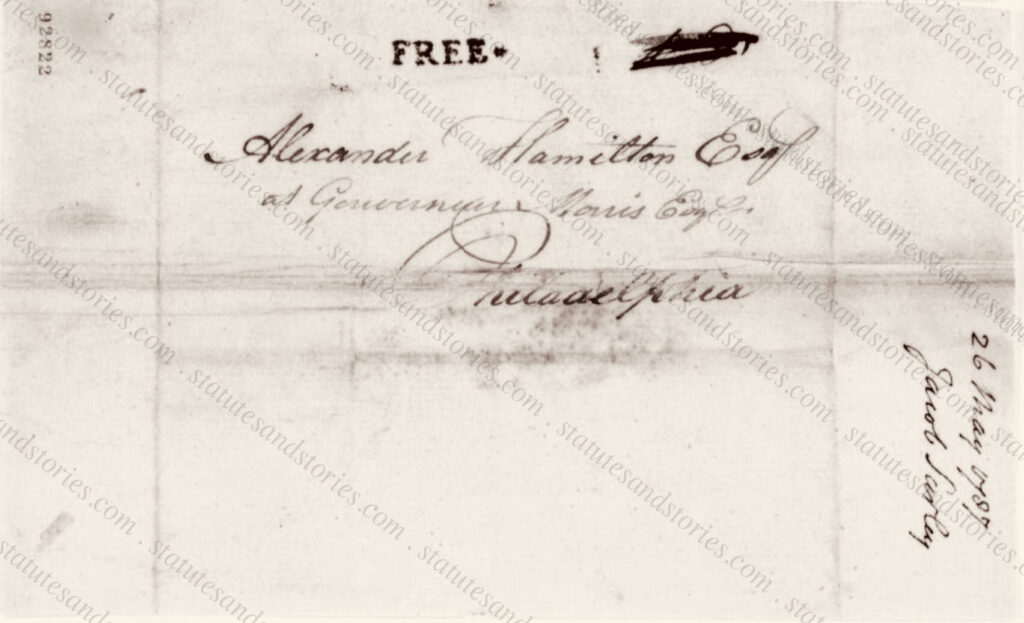
Given their close friendship, similar political orientation and objectives, it is simply hard to believe that Hamilton and Morris weren’t working together at Miss Dally’s. Indeed, as discovered by StatutesandStories.com earlier this year, Hamilton was receiving mail in May of 1787 “at Gouverneur Morris.” This should not be a surprise as Hamilton was coordinating with Morris on Morrisania legal matters since 1783. Click here for a discussion of how Gouverneur Morris, the youngest of four brothers, was able to purchase the Morrisania estate in 1787. Hamilton’s father-in-law and Governor Clinton were brought in as arbitrators to help settle protracted probate litigation within the Morris family, involving Revolutionary War claims for damages pending in London.
No Morris or Hamilton scholar had previously connected Alexander Hamilton to the Morrisania probate litigation. Yet, it is now clear that Hamilton and Morris were coordinating together for years, on multiple matters. This blog post theorizes that Hamilton and Morris continued closely collaborating at Miss Dally’s in September of 1787. Such coordination could have occurred prior to and after committee meetings of the Committee on Style. Indeed, it likely that meetings of the Committee on Style occurred at Miss Dally’s boarding house.
Committee on Style Venue Hypothesis
Set forth below (for the first time) is the hypothesis that Miss Dally’s boarding house would have been the most convenient, central location for all of the five members of the Committee on Style to meet (hereinafter the “Committee on Style Venue Hypothesis”). While there is no direct evidence where the Committee on Style met between September 8 and September 12, the Venue Hypothesis theorizes that Miss Dally’s boarding house was the ideal location for the Committee on Style, particularly for evening committee meetings.
The following circumstantial evidence supports the Committee on Style Venue Hypothesis:
- Two of the five members of the Committee were likely boarding at Miss Dally’s (Gouverneur Morris and Alexander Hamilton);
- Miss Dally’s was centrally located between the other boarding houses used by the other committee members;
- It made sense to meet at the location where Gouverneur Morris was residing, as Morris had been selected by the committee as the draftsman for the Constitution;
- Morris was a Philadelphia resident who likely had an office inside or alongside Miss Dally’s boarding house (potentially in one of the four “out houses” on the property);
- Miss Dally’s boarding house was more intimate than the larger City Tavern or Indian Queen where they might be interrupted by other delegates/boarders.
- Despite the thousands of pages of convention-related records complied by generations of historians, no primary sources answer the question where the Committee on Style met. For example, Madison did not take notes at the committee meetings. Had the Committee on Style been meeting at one of the other, larger boarding houses, this might have been observed and noted by the other delegates in their correspondence, journals or diaries. Thus, the absence of any records suggests that the Committee met at a quiet location where they would not be interrupted or disturbed.
Of the five committee members, Madison would have been located the furthest down Market Street as he resided at Mrs. House’s boarding house on the corner of 5th and Market. [11] Rufus King was boarding at City Tavern on Second Street near Walnut. [12] While Chairman Johnson had initially boarded with Rufus King at City Tavern, Johnson was forced to relocate to less expensive accommodations. [13] It is logical to ask whether Johnson might have tried to relocate to Mrs. Marshall’s to join his fellow Connecticut delegates Ellsworth and Sherman. [14] Mrs. Marshall’s was also located on Second between Walnut and Chestnut. His financial records suggests, however, that Chairman Johnson moved to more economical quarters to lodge with Silas Wilson further north on Callowhill Street between Second and Front Street.
Using boarding house locations contained in the “Philadelphia 1787” map created by Ann Toogood and the subsequent map included in Richard Beeman’s book, Plain, Honest Men, it is clear that geographically speaking Miss Dally’s boarding house would have been the most convenient, centrally located location for all five members of the Committee on Style. Moreover, two of the five members – Morris and Hamilton – were likely boarding at Miss Dally’s. And Gouverneur Morris likely had an office at or alongside Miss Dally’s where the committee could meet. Presumably the committee would have had access to beverages, snacks, candles, paper and other supplies at Miss Dally’s, particularly if Morris maintained his law office at or near Miss Dally’s. According to the property tax rolls, Miss Dally’s building was a total of 3,570 square feet (which presumably included the 4 out houses).

Pictured below is the property tax roll for 1787 listing Gouverneur Morris and Dr. Jones immediately under Miss Dally’s name, indicating that they were all residents in the property owned by Bartholomew Wistar.
As described by Delaware delegate George Read, Mrs. House’s lodging house was “very crowded” at the start of the Convention in May. According to Read, his room was “so small as not to admit of a second bed.” [15] For these reasons, it is expected that Miss Dally’s would have been more private, particularly if Gouverneur Morris had an office inside Miss Dally’s boarding house (or in an “out house” on the property).
While it would have been easy enough for the Committee on Style to meet at Independence Hall (or the library), at night it may have been more difficult logistically. Indeed, evidence suggests that delegates used to hold committee meetings at Miss Dally’s when Congress met in Philadelphia years earlier. For a large committee such as the various Committees of Eleven, a smaller boarding house might not have been ideal. But for the five member Committee on Style, it arguably made sense to meet at Miss Dally’s. To the extent that they were working under time pressure and had four items on their plate (Constitution, Cover Letter, Ratification Resolutions), it is likely that some of the committee’s work occurred at night. What other location would make more sense than the site where Gouverneur Morris (who was charged with the drafting of the Constitution) was boarding?


Lastly, it is worth considering the possibility that Gouverneur Morris might have boarded with Robert Morris and/or that the Committee on Style might have met at Robert Morris’ house. Importantly, there is no evidence that this was the case. To the contrary, the evidence discussed in Parts I and II indicate that Gouverneur Morris was paying rent to Miss Dally. Moreover, Gouverneur Morris was listed on the property tax rolls in 1787 as living with Miss Dally or on an “out house” on the property. Likewise, although Gouverneur Morris and Robert Morris were close business associates they were not related.

Yet another reason why Gouverneur Morris didn’t board with Robert Morris is provided by Robert Morris’ correspondence to his sons in Leipzig. By letter dated June 25, Robert Morris took pride in the fact that “General Washington is now our guest, having taken up his abode at my house during the time he remain in this city.” Although Farrand only cited a portion of the June 25th letter [16], a complete copy of the letter was obtained from the Huntington Library archives and is pictured above. Nowhere in the June 25 letter does Robert Morris mention that anyone else was boarding with Robert and Mary Morris, other than General Washington.
Perhaps the strongest reason why the work of the Committee likely occurred at Miss Dally’s boarding house is because both Hamilton and Morris board there. Historians have commented that it was “surprising” that Hamilton was selected for the Committee on September 8 since he had been absent from Philadelphia more than he was present. [17]
Historian Clinton Rossiter opines that only four of the members can be said to have honestly “earned their seats” on the committee. Hamilton, the “celebrated truant,” had only been back on the convention floor for three working days when he was elected to the Committee on Style. [18] According to historian David O. Stewart, “the inclusion of Hamilton, who had been absent for at least half of the Convention, was almost shocking.” [19] Yet, if there were specific reasons why Hamiton was selected for the Committee his selection would be less surprising.
Indeed, Hamilton wasn’t merely selected as one of the five members of the Committee. According to Madison’s notes, the committee members were selected by ballot and Hamilton’s name was in fact the second name listed. According to Professor John Kaminski this suggests that Hamilton received the second highest number of votes behind Chairman Johnson. Thus, either George Washington and/or the Convention at large had a reason to assign Hamilton to the Committee on Style. Having been given a mission, it can be assumed that Hamilton diligently performed it along with Gouverneur Morris at Miss Dally’s boarding house. Click here for a discussion of the Hamilton Authorship Thesis (“HAT”) which theorizes that Alexander Hamilton was placed on the Committee on Style to write the Constitution’s Cover Letter for George Washington’s signature.
In sum, if the Committee on Style Venue Hypothesis and the Hamilton Authorship Theory are both correct, it is likely that Alexander Hamilton drafted the Constitution’s Cover Letter at Miss Dally’s boarding house with Gouverneur Morris.
Sources:
[1] Charles Mee Jr., The Genius of the People at p. 268 (1987).
[2] Forrest McDonald, Alexander Hamilton: A Biography at p. 18 (1982).
[3] Peter Hoffer, For Ourselves and Our Posterity: The Preamble to the Federal Constitution in American History at p. 11 (2013). The prologue to Hoffer’s book is entitled “Dinner at Mrs. Dailey’s Boarding House,” in recognition of the significant role that the boarding house likely played for Hamilton and Morris, as members of the Committee on Style.
[4] David B. Ogden, Four Letters on the Death of Alexander Hamilton at p. 12 (1804).
[5] William Treanor, The Case of the Dishonest Scrivener: Gouverneur Morris and the Creation of the Federalist Constitution, 120 Mich Law Rev 28 (Oct. 2021).
[6] Ron Chernow, Alexander Hamilton at p. 157 (2004).
[7] Max Farrand, 1 The Records of the Federal Convention of 1787 at 529 (1911).
[8] 1 Farrand at p. 530.
[9] 1 Farrand at p. 552.
[10] John C. Miller, Alexander Hamilton and the Growth of the New Nation at p. 118 (1959) citing Hamilton’s 30 April 1781 letter to Robert Morris.
[11] David O. Stewart, The Summer of 1787 at p. 28 (2007).
[12] James H. Hutson, Supplement to Max Farrand’s The Records of the Federal Convention of 1787 at p. 227 (1987).
[13] 3 Farrand at 552; William Samuel Johnson: Daybook, July 18, 1787.
[14] Richard Beeman, Plain, Honest Men: The Making of the American Constitution at p. 78 (2009). Indeed, there might have been space at Mrs. Marshall’s because Oliver Ellsworth returned home on or August 23 to resume his duties on Connecticut Supreme Court. 3 Farrand at p. 587.
[15] 3 Farrand at p. 25.
[16] 3 Farrand at p. 49.
[17] Stewart at p. 239.
[18] Clinton Rositer, 1787: The Grand Convention at p. 224 (1966).
[19] David O. Stewart, Madison’s Gift: Five Partnerships that Built America at p. 41 (2015).
